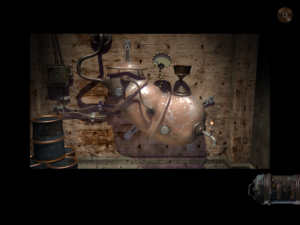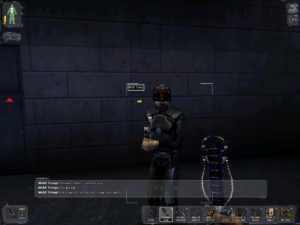I just spent pretty much an entire day playing Deus Ex (or, more accurately, an entire night, because it’s a very dimly-lit game, full of shadows suitable for skulking, and thus best played without ambient sunlight). It seems to me that this is a game best played in long sessions like this. It’s easy to get bogged down in tactics otherwise. If you play for only a half an hour, the focus of your session can wind up being something as trivial as making your way to the end of a tunnel, rather than the plot-level activities that such micro-goals make up. This, I think, is why I’ve only made significant progress on the weekends.
And significant progress it is, this time: I’ve finally reached the point in the story where I leave both New York and UNATCO behind, which seems like a good place to stop for the moment. I have a few comments on the way the shift in plot was handled. There will be spoilers, but in a way, it’s hard to spoil the story here, because everything of importance is so heavily foreshadowed.
First of all, turning against UNATCO is not only inevitable, but happens at a very specific point. I was not only surprised at this, I was surprised that I was surprised: I’ve been given plenty of warning, in game and out, about what was going to happen. But when the moment comes, it comes quite suddenly. Before the decisive mission, there’s a sense that you’re juggling loyalties. The player character’s boss, one Joseph Manderley, as much as told me that I’d have to start putting more effort into getting the real powers behind UNATCO to trust me, just before it all became moot.
Understand that this is only notable because the game continues to give the player more influence over the course of events than most games provide. Secondary characters live or die as a result of your actions. The entire New York segment of the game leads up to a confrontation at a hotel in which UNATCO troops, your former colleagues, come for you and your brother Paul, another rogue agent. You can take a stand alongside him, saving his life in the process, or slip out the back while he sacrifices himself to buy you time. Quite a few later conversations have to have versions for both branches, and there’s an entire sub-quest about finding his cadaver in MJ12’s secret medical research laboratories. If you escape, and evade capture, you get an optional boss fight with Anna Navarre, your cyborg mentor who earlier complained about your being too soft if you used nonlethal force against the NSF. It’s possible to ditch this fight even after it starts; again, later scenes accommodate her being alive or dead.
Defeat or escape from Navarre and you wind up in the one encounter that I believe to be completely unwinnable. You can make a pretty good go of it, though. It’s like the last few seconds of the first episode of Doom, where you suddenly find yourself surrounded by baddies and have no way to shoot them all: the episode simply ends when you die. According to legend, some exceptional Doom player actually did manage to win that fight, only to find himself stuck in a small room with no doors and no way to trigger the end. Similarly, on emerging from the subway tunnels in Deus Ex, even if I power up my defensive augmentations and don thermoptic camouflage and try to make a break for freedom, it seems like I’m stuck in a smallish area surrounded by invisible walls. At any rate, the next scripted plot event involves the player character escaping from a holding cell, so you have to get captured somehow. The interesting thing is how much choice you get about when and where. From the moment the troops come for you and Paul at the hotel, being defeated in combat results in capture instead of death. One way to skip the fight with Navarre is to simply get captured before you reach it. Lasting farther into the sequence gives you more experience points, and to a certain extent more story, but this is one case where player actions have consequences that aren’t terribly lasting. You’re going to wake up in that cell no matter what.
I assumed at first that the cell was simply one of the cells I had seen earlier in UNATCO HQ, where certain NFS officers wound up. It seemed a reasonable assumption, given that I had been captured by UNATCO troops and that Navarre, a UNATCO agent, stops by to taunt you if she’s still alive at that point. But no, it’s actually deep in a secret MJ12 compound, complete with more guards in MJ12 uniforms and scientists working on weird biological experiments. (Some cages contain strange bird-like creatures that bear an uncanny resemblance to current concepts of the velociraptor. I just can’t escape the dinosaurs these days, can I?) And there’s a glorious moment, after painstakingly wending your way through the ducts and hallways, when you finally reach the facility’s sole exit, and discover that the entire thing is the previously-inaccessible “Restricted” area in the lower reaches of UNATCO HQ. A connection between MJ12 and UNATCO is pretty much a given by that point, but providing a literal “connection” in the sense of hallway makes it all that much more satisfying somehow. It turns the whole conspiracy from allegations about individuals to something so fundamental it’s built into the very architecture, a fact on the ground (or under the ground, as the case may be). Perhaps this is why the Masons are such a popular subject for conspiracy theories.
The game has been pretty good about reusing environments in different ways, but I think UNATCO HQ is the first area that you initially become familiar with while it’s safe, and only later becomes full of enemies. The enemies are, of course, the people who you earlier befriended — all the more reason to stick to nonlethal force, says I. Except not all of them are enemies: most of the NPCs with names, found in their usual offices, are on your side, at least if you play it like I did. One guy helps you escape but is otherwise loyal to UNATCO (expressing dismay that it’s been corrupted but hope that it can be redeemed), another expresses an intention of joining you in Hong Kong as soon as he gets the chance. Another gives you a choice, asking whether he should come with you or stay behind as your agent, feeding you information about UNATCO’s doings. In other words, conspiring with you. Creating a new conspiracy.
Let’s hope it turns out better than the last one. Presumably this is an ad-hoc conspiracy, to be dropped once its aims are met, much as Cincinnatus voluntarily relinquished the dictatorship of Rome. There’s a brief mention of Cincinnatus in the game, a passage in a book on the Society of Cincinnati, an order founded shortly after the American Revolution. It makes the dubious claim that the Society exists primarily to seize dictatorial control over the United States in the event that it becomes necessary. I can’t vouch for the book’s reliability even within the context of the game — it could well be just another conspiracy theory thrown out in the name of inclusiveness. But if the authors want us to read that passage, it’s probably because they want us to think about its implications for the player’s actions. But we’ll see.
 One of the first things I found this time around was an outsized organ attached to a wall, with an intake funnel and an outflow valve, like something out of a Fritz Kahn illustration. I’m not sure what organ it’s supposed to be — to me, it looks like a pancreas more than anything else, but that doesn’t fit the plumbing. At any rate, it was clearly a new type of puzzle: one based on interacting with biological mechanisms rather than just displaying knowledge of them. Mentally squinting, I think I can make out some less-obvious examples of this in the architecture, situations that are symbols of the processes that I’m supposed to be learning about, like how the circuitous entry into the inner part of the microbiology lab reflects the way a carrier protein transports a molecule through a cell membrane.
One of the first things I found this time around was an outsized organ attached to a wall, with an intake funnel and an outflow valve, like something out of a Fritz Kahn illustration. I’m not sure what organ it’s supposed to be — to me, it looks like a pancreas more than anything else, but that doesn’t fit the plumbing. At any rate, it was clearly a new type of puzzle: one based on interacting with biological mechanisms rather than just displaying knowledge of them. Mentally squinting, I think I can make out some less-obvious examples of this in the architecture, situations that are symbols of the processes that I’m supposed to be learning about, like how the circuitous entry into the inner part of the microbiology lab reflects the way a carrier protein transports a molecule through a cell membrane. Comments(0)
Comments(0)